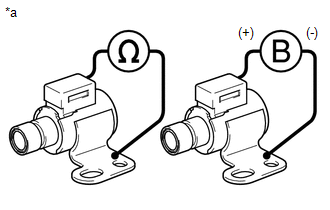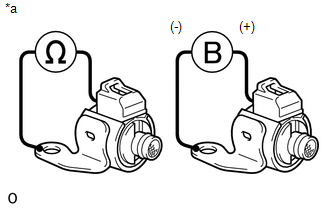Toyota 4Runner: Inspection
INSPECTION
PROCEDURE
1. INSPECT SHIFT SOLENOID VALVE SR
.png)
(a) Measure the resistance according to the value(s) in the table below.
Standard Resistance:
|
Tester Connection |
Condition |
Specified Condition |
|---|---|---|
|
Shift solenoid valve SR connector terminal - Shift solenoid valve SR body |
20°C (68°F) |
11 to 15 Ω |
|
*a |
Component without harness connected (Shift Solenoid Valve SR) |
(b) Apply 12 V battery voltage to the shift solenoid valve and check that the valve moves and makes an operating noise.
OK:
|
Measurement Condition |
Specified Condition |
|---|---|
|
Valve moves and makes an operating noise |
If the result is not as specified, replace the solenoid valve.
2. INSPECT SHIFT SOLENOID VALVE SL1 AND SL2
.png)
(a) Measure the resistance according to the value(s) in the table below.
Standard Resistance:
|
Tester Connection |
Condition |
Specified Condition |
|---|---|---|
|
1 - 2 |
20°C (68°F) |
5.0 to 5.6 Ω |
|
*a |
Component without harness connected (Shift Solenoid Valve) |
(b) Apply 12 V battery voltage to the shift solenoid valve and check that the valve moves and makes an operating noise.
OK:
|
Measurement Condition |
Specified Condition |
|---|---|
|
Valve moves and makes an operating noise |
If the result is not as specified, replace the solenoid valve.
3. INSPECT SHIFT SOLENOID VALVE SLT AND SLU
.png)
(a) Measure the resistance according to the value(s) in the table below.
Standard Resistance:
|
Tester Connection |
Condition |
Specified Condition |
|---|---|---|
|
1 -2 |
20°C (68°F) |
5.0 to 5.6 Ω |
|
*a |
Component without harness connected (Shift Solenoid Valve) |
(b) Apply 12 V battery voltage to the shift solenoid valve and check that the valve moves and makes an operating noise.
OK:
|
Measurement Condition |
Specified Condition |
|---|---|
|
Battery positive (+) with a 21 W bulb → Terminal 2 Battery negative (-) → Terminal 1 |
Valve moves and makes an operating noise |
If the result is not as specified, replace the solenoid valve.
4. INSPECT SHIFT SOLENOID VALVE S1

(a) Measure the resistance according to the value(s) in the table below.
Standard Resistance:
|
Tester Connection |
Condition |
Specified Condition |
|---|---|---|
|
Shift solenoid valve S1 connector terminal - Shift solenoid valve S1 body |
20°C (68°F) |
11 to 15 Ω |
|
*a |
Component without harness connected (Shift Solenoid Valve S1) |
(b) Apply 12 V battery voltage to the shift solenoid valve and check that the valve moves and makes an operating noise.
OK:
|
Measurement Condition |
Specified Condition |
|---|---|
|
Valve moves and makes an operating noise |
If the result is not as specified, replace the solenoid valve.
5. INSPECT SHIFT SOLENOID VALVE S2

(a) Measure the resistance according to the value(s) in the table below.
Standard Resistance:
|
Tester Connection |
Condition |
Specified Condition |
|---|---|---|
|
Shift solenoid valve S2 connector terminal - Shift solenoid valve S2 body |
20°C (68°F) |
11 to 15 Ω |
|
*a |
Component without harness connected (Shift Solenoid Valve S2) |
(b) Apply 12 V battery voltage to the shift solenoid valve and check that the valve moves and makes an operating noise.
OK:
|
Measurement Condition |
Specified Condition |
|---|---|
|
Valve moves and makes an operating noise |
If the result is not as specified, replace the solenoid valve.
 Disassembly
Disassembly
DISASSEMBLY
PROCEDURE
1. REMOVE SHIFT SOLENOID VALVE SR
(a) Remove the 2 bolts and solenoid valve.
2. REMOVE SHIFT SOLENOID VALVE SLU
...
 Installation
Installation
INSTALLATION
PROCEDURE
1. INSTALL TRANSMISSION VALVE BODY ASSEMBLY
(a) Install the spring and check ball body.
(b) Insert the pin of the manual valve into the hole of the manual valve
...
Other materials about Toyota 4Runner:
Removal
REMOVAL
PROCEDURE
1. REMOVE FRONT WHEEL
2. REMOVE FRONT FENDER MUDGUARD LH (w/o Intuitive Parking Assist System)
3. REMOVE ROCKER PANEL MOULDING COVER LH (w/o Intuitive Parking Assist System)
4. REMOVE FRONT FENDER MOULDING SUB-ASSEMBLY LH (w/o Intu ...
Amplifier Antenna
Components
COMPONENTS
ILLUSTRATION
Removal
REMOVAL
PROCEDURE
1. REMOVE ROOF HEADLINING ASSEMBLY
(See page )
2. REMOVE AMPLIFIER ANTENNA ASSEMBLY
(a) Disconnect the 3 connectors.
( ...
0.0089
